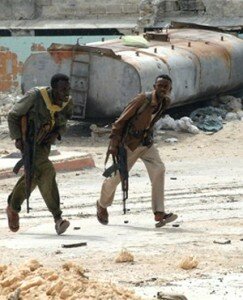 Mogadishu – Heavy fighting between Somali insurgents and pro-government troops has killed at least 43 people over two days, as AU peacekeepers used tanks to help the beleaguered government beat back an insurgent attack, officials said on Thursday.
Mogadishu – Heavy fighting between Somali insurgents and pro-government troops has killed at least 43 people over two days, as AU peacekeepers used tanks to help the beleaguered government beat back an insurgent attack, officials said on Thursday.
Militants attacking from the north on Wednesday reached to within 2km of the presidential place in the heart of the capital, Mogadishu, before AU peacekeepers in tanks reinforced government troops, residents said.
Ali Muse, the head of Mogadishu’s ambulance service, said he saw 40 bodies lying in the streets over the two days of fighting on Wednesday and Thursday. Nearly 150 were wounded, mostly civilians, he said.
“The fighting was heavier than that of yesterday,” said Muse. “Our ambulances are sometimes caught in the crossfire. Our ambulance crews use dangerous streets and they have to dodge mortars and bullets. Sometimes it takes us hours to reach injured civilians and because of that they bleed to death.”
Trapped residents
Three of the wounded brought in on Wednesday died overnight, said Abdi Mahad, a doctor at Medina Hospital.
“A mortar shell has just fallen into the house next to me. We can hear neighbours crying and can see smoke over their building, but I do not know if there is a casualty,” Sahra Haji Abdulle said by phone from her home in northern Mogadishu. “We could hardly sleep last night. The sky was lit up by shelling all night. We have nowhere to escape.”
More than half of those living in Somalia’s seaside capital have fled. Those remaining are mostly too poor to move or fear being attacked as they leave. Compounding their dilemma, an Islamist group issued a series of demands at the beginning of the year that caused the UN’s World Food Programme to pull out of much of southern Somalia. Soon families fleeing into the countryside may find nothing to eat.
Neither the Islamists nor the UN-backed government can take and hold enough ground for a decisive victory.
AU peacekeepers
The government is supported by around 5 300 AU peacekeepers, whose tanks and armoured vehicles help them to outgun the insurgents. The insurgents favour mobile hit-and-run attacks, using snipers and mortar fire to make it hard for the government’s poorly trained and irregularly paid soldiers to hold their position.
The peacekeepers used tanks to help government forces when the insurgents got within a mile of the presidential palace, said resident Omar Salad. Other residents confirmed his account.
The insurgents, the government and the peacekeepers have all been criticised by human rights groups for indiscriminately firing into and shelling residential neighbourhoods. But the criticism has had little effect.
“The rebels launched the attack and we had a right to defend. We fended them off and killed many of them, thank God,” said Yusuf Mohamed Siyad, Somalia state minister for defence.
Al Shebab
“We have forced our enemy to taste the pain of our weapons,” said a spokesperson for the Islamist al Shebab militia, Sheik Ali Mohamud Rage.
The government hopes to break the stalemate with an upcoming offensive, but its launch has been delayed by problems that include inadequate equipment and training. There has been a surge in fighting since the beginning of the year, when the offensive was first being publicly discussed.
Even if the government push succeeds, few Somalis trust an administration that has failed to deliver even a semblance of services or security more than a year after it took power.
The arid Horn of Africa nation has not had a functioning government since the overthrow of a socialist dictator in 1991. Its civil war, which began with clan warfare, has morphed in recent years into a fight between an administration favoured by the international community and an Islamist insurgency backed by hundreds of newly arrived foreign fighters.
- SAPA through News24.com



